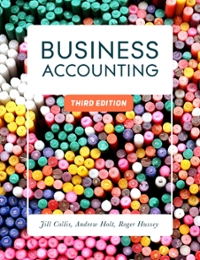Question
I would just like to confirm that my answers are correct to the questions. Ferguson Equipment, Inc. manufactures custom-designed manufacturing equipment. Ferguson had recently received
I would just like to confirm that my answers are correct to the questions.
Ferguson Equipment, Inc. manufactures custom-designed manufacturing equipment. Ferguson had recently received a request to manufacture 40 units of a specialized machine at a price lower than it normally accepts. Marketing manager Emily Dorr indicated that if the order were accepted at that price, the company could expect additional orders from the same customer; in fact, if the company could offer this price in the market generally, she believed that sales of this machine would increase by 50 percent.
Cleon Skowsen, president of Ferguson, was skeptical about accepting the order. The company had a policy not to accept any order that did not provide revenues at least equal to its full manufacturing cost plus 15 percent. The price offered was $2,100 per unit. However, before a final decision was made, Cleon decided to request information on the estimated cost per unit. He was concerned because the company was experiencing increased competition, and the number of new orders was dropping.
The costs of producing the specialized machine are as follows:
Direct materials $ 24,000
Direct labour 20,000
Overhead 37,000 *
Total $ 81,000
Units 40
Unit cost $ 2,025
* Overhead is currently allocated based on an expected volume of 400,000 direct labour hours.
The controllers office had recently researched the possibility of using activity-based multiple overhead rates instead of the single rate currently in use. The controller had promised more accurate product costing, and Cleon was curious about how this approach would affect the pricing of this particular machine. Within 24 hours, the controller had assembled the following data regarding overhead:
Overhead cost pools Costs
Depreciation, equipment $ 300,000
Power (machine usage) 500,000
Material handling 800,000
Rework costs 300,000
Scrap costs 640,000
Depreciation, building 500,000
Supervision (plant-wide) 200,000
Other plant-wide overhead 460,000
Total $ 3,700,000
Expected activity for selected cost drivers for the year are:
Machine hours 100,000
Kilowatt hours 100,000
Material moves 10,000
Units reworked 2,000
Units scrapped 1,000
Direct labour hours 400,000
The overhead rate for facility-level activities is based on direct labour hours.
Estimated data for the potential job, based on production of 40 units, are:
Direct materials $ 24,000
Direct labour (4,000 hours) $ 20,000
Number of machine hours 1,000
Number of kilowatt hours 1,000
Number of material moves 6
Number of units reworked 1
Number of units scrapped 3
Required:
Given the current allocation and normal operating conditions, would Ferguson Equipment accept the job? Support your answer with calculations.
Policy: full manufacturing cost plus 15%.... $2025 X 15%= $304 + $2025 = $2329
Ferguson would not accept the job due to the fact that it goes against its policy of full manufacturing cost plus 15%. Ferguson would have to get $2329 to accept the job if it was to follow its policy.
Prepare a schedule calculating the unit cost of the specialized machine using activity-based costing.
| Cost pools | Cost drivers | rate | quantity | Total for 40 |
| Dep, equip-300,000 | Machine hrs 100,000 | $3 | 1000 | $3000 |
| Power 500,000 | Kilowatt hrs 100,000 | $5 | 1000 | $5000 |
| Material handling 800,000 | Material moves 10,000 | $80 | 6 | $480 |
| Rework 300,000 | Units reworked 2,000 | $150 | 1 | $150 |
| Scrap 640,000 | Units scrapped 1,000 | $640 | 3 | $1920 |
| Supervision 200,000 | Direct labour hrs 400,000 | $0.5 | 4,000 | $2000 |
|
|
|
|
| $56,550 |
$24,000 + $20,000 +$56,550 / 40 = $2514
These two costs are not factored in: Depreciation, building 500,000 & Other plant-wide overhead 460,000
Based on the ABC results, what course of action would you recommend for Ferguson Equipment regarding this order? Support your answer.
The cost of the product using ABC would be $2514 per unit which is greater than $2100 so just producing the product costs more than the company would like to buy it so if Ferguson was to take the contact they would be taking a loss for each unit as well as going against its policy of full manufacturing cost plus 15%.
Which method of overhead allocation would you recommend Ferguson use? Why? Give both pros and cons for your recommendation.
I would recommend Ferguson to use predetermined method instead of the ABC method the ABC
is more accurate but it is a great deal more expensive to implement and in this situation the results are the same so why incur the extra expense.
Step by Step Solution
There are 3 Steps involved in it
Step: 1

Get Instant Access to Expert-Tailored Solutions
See step-by-step solutions with expert insights and AI powered tools for academic success
Step: 2

Step: 3

Ace Your Homework with AI
Get the answers you need in no time with our AI-driven, step-by-step assistance
Get Started


